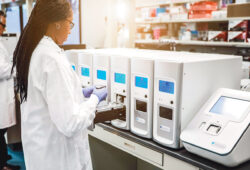How digital imaging & artificial intelligence are changing the field of diagnostics
Digital imaging and artificial intelligence (AI) are transforming the field of diagnostics, making this an exciting and pivotal time to be in the radiology and pathology fields.

“AI is the next wave of learning,” says Luann Culbreth, MEd, MBA, RT, FACHE, former Director, Radiology & Cardiovascular Services, Clinical Operations, HealthTrust. “It’s really going to take off and transform a lot of the ways in which we provide care and will ultimately help us provide care more efficiently and accurately.”
Boosting accuracy
AI takes pattern recognition to an entirely different level, giving radiologists and physicians a powerful tool that can potentially make diagnosis more precise, says Culbreth. For example, a recent study published in Cancer Biomarkers found that an AI tool examining CT scans was able to detect early signs of pancreatic cancer so subtle they couldn’t have been seen by the human eye.
The average classification accuracy of the tool was 86% in predicting which patients would develop pancreatic cancer.
Still, for AI’s potential as an accuracy tool, it must get “smarter” with time. “For that potential to be realized, appropriate training of AI programs needs to happen,” Culbreth notes. “You’ve got to account for variabilities.”
For instance, AI models need to be trained to recognize many variables in human physiology—a person’s heart may be on the right side of their chest, or that skin thicknesses and bone structures are not necessarily the same for every person. As algorithms are refined over time, AI’s ability to make more accurate diagnoses could lead to quicker medical evaluation and, ultimately, improved health outcomes for patients.
Targeting treatments
Digital imaging technologies and AI will also help to facilitate the development of precision medicine in the lab, says Christa Pardue, MBA, MT(AMT), former Director, Laboratory Services, Clinical Operations, HealthTrust. Digitized laboratory equipment can not only scan slides more quickly, but it also has the power to process higher levels of stain, pinpointing areas that would be difficult to see with human eyes.

“The sensitivity can be dialed up even more when AI algorithms are trained to look for and identify specific receptors, for example, if specific drugs would be beneficial to a patient,” Pardue explains.
Reducing the load
With the increase in computing power of digital imaging technologies comes more data—a lot more data, agree Culbreth and Pardue. “In the old days of film,” explains Culbreth, “radiologists had maybe two or three different views to look at. Now they’ve got thousands. The workload to sort through all of those digital images is truly overwhelming.”
But properly trained AI programs can help to reduce the burden on radiologists and pathologists by allowing them to process the abundance of images and slides quickly and flag those that need attention. The technology serves as an invaluable support to clinicians. “It’s not going to replace a radiologist, by any means,” Culbreth stresses, “or any physician, for that matter. It’s going to assist them.”
The challenges of digital transformation
Aside from needing to ensure that AI algorithms are appropriately refined, the digital transformation of diagnostics has a few other challenges. Chief among these is data storage, says Pardue. “Data storage is so expensive that it’s cheaper for us to build a whole facility to store glass slides than it is to store data.” In addition to the costs of data storage, there are also concerns around security, and whether to consider storing data on-site or in the cloud, adds Culbreth.
While the challenges are not trivial, they’re also all manageable and resolvable by taking them one step at a time and with the knowledge that there are supports available to help facilitate the digital transformation, says Culbreth.
Research and development in AI and digital imaging is advancing and growing rapidly, and suppliers are evolving to make sure they can best serve the needs of their clients, so no one will be left out or left behind. HealthTrust is looking into how to bring resources into its portfolio to guide appropriate use criteria, clinical decision-making and workflow optimization, among many other things. “Nobody’s out on their own,” says Culbreth. “We have a lot to learn; let’s learn it together intelligently.”
To learn more about digital diagnostics, email Luann Culbreth at luann.culbreth@healthtrustpg.com
Share Email AI, Diagnostics, Q3 2022, Radiology





